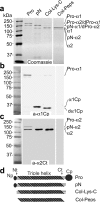Collagen fibril formation. A new target to limit fibrosis
- PMID: 18650436
- PMCID: PMC2533774
- DOI: 10.1074/jbc.M804272200
Collagen fibril formation. A new target to limit fibrosis
Abstract
We present a concept for reducing formation of fibrotic deposits by inhibiting self-assembly of collagen molecules into fibrils, a main component of fibrotic lesions. Employing monoclonal antibodies that bind to the telopeptide region of a collagen molecule, we found that blocking telopeptide-mediated collagen/collagen interactions reduces the amount of collagen fibrils accumulated in vitro and in keloid-like organotypic constructs. We conclude that inhibiting extracellular steps of the fibrotic process provides a novel approach to limit fibrosis in a number of tissues and organs.
Figures





Similar articles
-
Asporin inhibits collagen matrix-mediated intercellular mechanocommunications between fibroblasts during keloid progression.FASEB J. 2021 Jul;35(7):e21705. doi: 10.1096/fj.202100111R. FASEB J. 2021. PMID: 34105826
-
Target-Specific Delivery of an Antibody That Blocks the Formation of Collagen Deposits in Skin and Lung.Monoclon Antib Immunodiagn Immunother. 2017 Oct;36(5):199-207. doi: 10.1089/mab.2017.0044. Epub 2017 Oct 3. Monoclon Antib Immunodiagn Immunother. 2017. PMID: 28972447 Free PMC article.
-
Testing the anti-fibrotic potential of the single-chain Fv antibody against the α2 C-terminal telopeptide of collagen I.Connect Tissue Res. 2014 Apr;55(2):115-22. doi: 10.3109/03008207.2013.862528. Epub 2014 Jan 10. Connect Tissue Res. 2014. PMID: 24195607 Free PMC article.
-
Meprin α and meprin β: Procollagen proteinases in health and disease.Matrix Biol. 2015 May-Jul;44-46:7-13. doi: 10.1016/j.matbio.2015.01.010. Epub 2015 Jan 21. Matrix Biol. 2015. PMID: 25617491 Review.
-
Developmental roles of the BMP1/TLD metalloproteinases.Birth Defects Res C Embryo Today. 2006 Mar;78(1):47-68. doi: 10.1002/bdrc.20060. Birth Defects Res C Embryo Today. 2006. PMID: 16622848 Review.
Cited by
-
Therapeutic Strategies to Overcome Fibrotic Barriers to Nanomedicine in the Pancreatic Tumor Microenvironment.Cancers (Basel). 2023 Jan 24;15(3):724. doi: 10.3390/cancers15030724. Cancers (Basel). 2023. PMID: 36765684 Free PMC article. Review.
-
Preparation and Characterization of Hydroxylated Recombinant Collagen by Incorporating Proline and Hydroxyproline in Proline-Deficient Escherichia coli.Bioengineering (Basel). 2024 Sep 27;11(10):975. doi: 10.3390/bioengineering11100975. Bioengineering (Basel). 2024. PMID: 39451351 Free PMC article.
-
Bone Mineralization in Electrospun-Based Bone Tissue Engineering.Polymers (Basel). 2022 May 23;14(10):2123. doi: 10.3390/polym14102123. Polymers (Basel). 2022. PMID: 35632005 Free PMC article. Review.
-
The impact of cholesterol deposits on the fibrillar architecture of the Achilles tendon in a rabbit model of hypercholesterolemia.J Orthop Surg Res. 2019 Jun 10;14(1):172. doi: 10.1186/s13018-019-1217-7. J Orthop Surg Res. 2019. PMID: 31182124 Free PMC article.
-
Mechanisms of reducing joint stiffness by blocking collagen fibrillogenesis in a rabbit model of posttraumatic arthrofibrosis.PLoS One. 2021 Sep 7;16(9):e0257147. doi: 10.1371/journal.pone.0257147. eCollection 2021. PLoS One. 2021. PMID: 34492074 Free PMC article.
References
-
- Prockop, D. J., and Kivirikko, K. I. (1995) Annu. Rev. Biochem. 64 403–434 - PubMed
-
- Colige, A., Vandenberghe, I., Thiry, M., Lambert, C. A., Van Beeumen, J., Li, S. W., Prockop, D. J., Lapiere, C. M., and Nusgens, B. V. (2002) J. Biol. Chem. 277 5756–5766 - PubMed
-
- Kessler, E., Takahara, K., Biniaminov, L., Brusel, M., and Greenspan, D. S. (1996) Science 271 360–362 - PubMed
-
- Addicks, E. M., Quigley, H. A., Green, W. R., and Robin, A. L. (1983) Arch. Ophthalmol. 101 795–798 - PubMed
Publication types
MeSH terms
Substances
Grants and funding
LinkOut - more resources
Full Text Sources
Other Literature Sources
Research Materials
Miscellaneous

